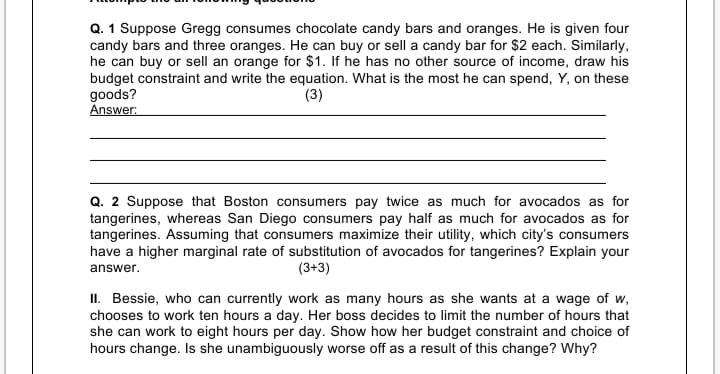Q. 1 Suppose Gregg consumes chocolate candy bars and oranges. He is given four candy bars and three oranges. He can buy or sell a candy bar for $2 each. Similarly, he can buy or sell an orange for $1. If he has no other source of income, draw his budget constraint and write the equation. What is the most he can spend, Y, on these goods? (3)
Q. 1 Suppose Gregg consumes chocolate candy bars and oranges. He is given four candy bars and three oranges. He can buy or sell a candy bar for $2 each. Similarly, he can buy or sell an orange for $1. If he has no other source of income, draw his budget constraint and write the equation. What is the most he can spend, Y, on these goods? (3)
Principles of Microeconomics
7th Edition
ISBN:9781305156050
Author:N. Gregory Mankiw
Publisher:N. Gregory Mankiw
Chapter21: The Theory Of Consumer Choice
Section: Chapter Questions
Problem 1PA
Related questions
Question

Transcribed Image Text:Q. 1 Suppose Gregg consumes chocolate candy bars and oranges. He is given four
candy bars and three oranges. He can buy or sell a candy bar for $2 each. Similarly,
he can buy or sell an orange for $1. If he has no other source of income, draw his
budget constraint and write the equation. What is the most he can spend, Y, on these
goods?
Answer:
(3)
Q. 2 Suppose that Boston consumers pay twice as much for avocados as for
tangerines, whereas San Diego consumers pay half as much for avocados as for
tangerines. Assuming that consumers maximize their utility, which city's consumers
have a higher marginal rate of substitution of avocados for tangerines? Explain your
answer.
(3+3)
II. Bessie, who can currently work as many hours as she wants at a wage of w,
chooses to work ten hours a day. Her boss decides to limit the number of hours that
she can work to eight hours per day. Show how her budget constraint and choice of
hours change. Is she unambiguously worse off as a result of this change? Why?
Expert Solution
This question has been solved!
Explore an expertly crafted, step-by-step solution for a thorough understanding of key concepts.
This is a popular solution!
Trending now
This is a popular solution!
Step by step
Solved in 2 steps

Knowledge Booster
Learn more about
Need a deep-dive on the concept behind this application? Look no further. Learn more about this topic, economics and related others by exploring similar questions and additional content below.Recommended textbooks for you

Principles of Microeconomics
Economics
ISBN:
9781305156050
Author:
N. Gregory Mankiw
Publisher:
Cengage Learning

Principles of Economics (MindTap Course List)
Economics
ISBN:
9781305585126
Author:
N. Gregory Mankiw
Publisher:
Cengage Learning


Principles of Microeconomics
Economics
ISBN:
9781305156050
Author:
N. Gregory Mankiw
Publisher:
Cengage Learning

Principles of Economics (MindTap Course List)
Economics
ISBN:
9781305585126
Author:
N. Gregory Mankiw
Publisher:
Cengage Learning


Economics: Private and Public Choice (MindTap Cou…
Economics
ISBN:
9781305506725
Author:
James D. Gwartney, Richard L. Stroup, Russell S. Sobel, David A. Macpherson
Publisher:
Cengage Learning

Microeconomics: Private and Public Choice (MindTa…
Economics
ISBN:
9781305506893
Author:
James D. Gwartney, Richard L. Stroup, Russell S. Sobel, David A. Macpherson
Publisher:
Cengage Learning
